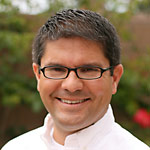Dr. Kevork Abazajian is an associate professor of physics and astronomy at the University of California, Irvine. His research interests include dark matter particle production in the early universe and its detection today; precision cosmology and dark energy; neutrino physics in the early universe and supernovae; galaxy formation theory and statistics; primordial nucleosynthesis; and gamma ray bursts. A candidate dark matter signal was detected in 2014 with space telescopes using techniques he discovered with his colleagues in 2001. There will be dedicated follow-up NASA sounding rocket missions to look for the signal in 2018 to 2019. Dr. Abazajian earned his Ph.D. and M.S. in physics from the University of California, San Diego, and his B.S. in Physics from the University of Houston, University Park.
According to Dr. Kevork Abazajian, “The power of applying scientific methods in public policy is so underappreciated.” Abazajian’s interest in understanding our universe extends beyond his research in astrophysics. Science is allowing us to discover how our universe works and how nature works here on earth, but Abazajian—with his passion for knowing how things work—believes that we do not often enough apply a scientific approach to solving human social and political problems.
“There’s this potential for great scientific achievement in our society and a history of it as well,” he reflects, but the potential for science to solve the problems of human society "is really strongly underappreciated—particularly from people in the public policy world." Abazajian hopes to help change this pattern through his engagement in local politics and his efforts to spur scientific understanding in the general public and inspire a greater love for science among young people.
Passion for science
Abazajian grew up in Texas in a town just outside of the Lyndon B. Johnson Space Center. When he was 8 years old, he asked his parents to take him to see the moon rocks at the Space Center and remembers thinking, “I want to study space.” Reading popular science books about quasars and quantum mechanics intensified Abazajian’s early curiosity about space exploration and sparked his interest in studying astronomy and physics.
As a scientist, Abazajian has been involved in numerous research projects contributing to our deeper understanding of the origins, structure, and composition of our universe. He contributed to the Sloan Digital Sky Survey at Fermilab, America’s premier particle physics laboratory. This is a large survey of galaxies that will provide a 3D map of approximately a million galaxies and quasars. Abazajian’s most recent research detects and analyzes signals from far away clusters of galaxies as evidence for understanding dark matter. His research group published findings on a source of gamma rays coming from the center of our galaxy and interpreted these rays as evidence for dark matter. Discover magazine featured this research as #8 in the top 100 stories of 2012.
Spurring public appreciation for science and science-based policies
Believing that instilling a greater appreciation for science in the public can help society achieve its full potential, Abazajian regularly shares his expertise with his local community by volunteering at an observatory. Astronomical societies as well as groups of visitors come and look at constellations and planets through telescopes. Afterwards, he holds astronomical talks intended for either a general audience or for youth. “These little things can instill and inspire an interest in science for young people,” he notes, reflecting on his early memories of the Johnson Space Center and the great joy he takes in sharing the wonder of discovery with the public, especially young people.
Having been involved in youth outreach since early in his career, Abazajian is currently developing a web interface where high school science teachers can ask questions about cosmology or particle physics that will be answered by professors. Abazajian envisions a site where physics becomes accessible—where teachers can take information from physicists and use it to enhance the material they are teaching and expand students’ understanding and perspective. Abazajian sees the interface as a tool with a reach beyond the classroom, too. He speculates, “it will probably be helpful to people in general … basically it’s just one way to get people involved.”
When he moved to Orange County, Abazajian became active in local politics. He is concerned about an anti-science trend among elected officials in his area and has canvassed for candidates he thinks will make more science-informed policy decisions. Ultimately, Abazajian says of his choices to become a research scientist and an actively engaged citizen, “I didn’t just want to work for a company to make a better widget—probably get a good salary doing that—but I was motivated to do science to better humanity.”
